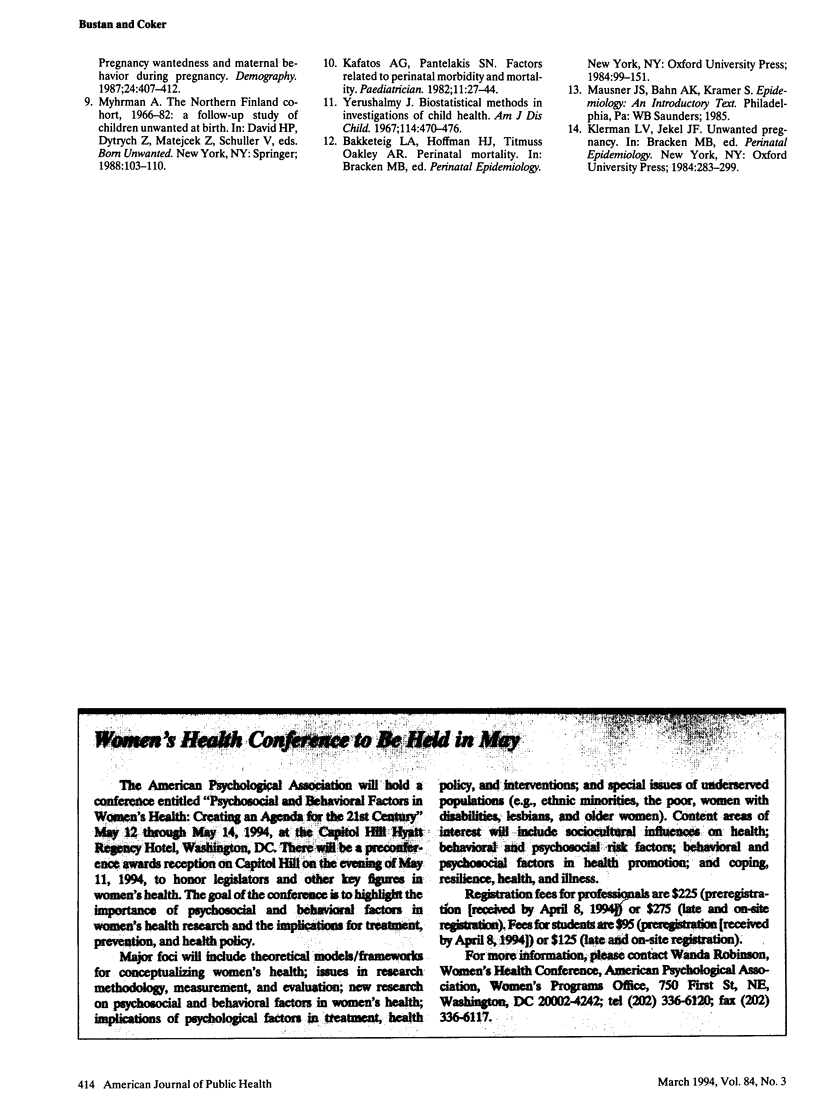Abstract
OBJECTIVES. Reduced options for fertility control over the past decade have increased the rates of unwanted pregnancy. We evaluated whether a woman's negative attitude toward her pregnancy increased the risk of perinatal mortality, in a large, prospective cohort study. METHODS. The association between attitude toward the pregnancy and perinatal mortality was evaluated in a longitudinal cohort study of 8823 married, pregnant patients enrolled from 1959 to 1966 in the Child Health and Development Studies. RESULTS. Women who reported during the first trimester of prenatal care that the pregnancy was unwanted were more than two times more likely to deliver infants who died within the first 28 days of life than were women reporting accepted pregnancies. A positive attitude toward pregnancy was not associated with fetal death or post-neonatal death. CONCLUSIONS. These data, collected when induced abortions were illegal, may have important implications for the 1990s. If maternal attitude toward the pregnancy is associated with neonatal mortality and abortion laws change such that access is restricted, infant mortality may increase because a greater proportion of births will be unwanted.
Full text
PDF



Selected References
These references are in PubMed. This may not be the complete list of references from this article.
- Baldwin W., Cain V. S. The children of teenage parents. Fam Plann Perspect. 1980 Jan-Feb;12(1):34-9,42-3. [PubMed] [Google Scholar]
- Kafatos A. G., Pantelakis S. N. Factors related to perinatal morbidity and mortality. Risk factors in pregnancy influencing perinatal morbidity and mortality. Paediatrician. 1982;11(1-2):27–44. [PubMed] [Google Scholar]
- Lia-Hoagberg B., Rode P., Skovholt C. J., Oberg C. N., Berg C., Mullett S., Choi T. Barriers and motivators to prenatal care among low-income women. Soc Sci Med. 1990;30(4):487–495. doi: 10.1016/0277-9536(90)90351-r. [DOI] [PubMed] [Google Scholar]
- Sable M. R., Stockbauer J. W., Schramm W. F., Land G. H. Differentiating the barriers to adequate prenatal care in Missouri, 1987-88. Public Health Rep. 1990 Nov-Dec;105(6):549–555. [PMC free article] [PubMed] [Google Scholar]
- Weller R. H., Eberstein I. W., Bailey M. Pregnancy wantedness and maternal behavior during pregnancy. Demography. 1987 Aug;24(3):407–412. [PubMed] [Google Scholar]
- Williams L. B. Determinants of unintended childbearing among ever-married women in the United States: 1973-1988. Fam Plann Perspect. 1991 Sep-Oct;23(5):212-5, 221. [PubMed] [Google Scholar]
- Yerushalmy J. Biostatistical methods in investigations of child health. Am J Dis Child. 1967 Nov;114(5):470–476. doi: 10.1001/archpedi.1967.02090260058003. [DOI] [PubMed] [Google Scholar]
- Zuravin S. J. Unplanned childbearing and family size: their relationship to child neglect and abuse. Fam Plann Perspect. 1991 Jul-Aug;23(4):155–161. [PubMed] [Google Scholar]


